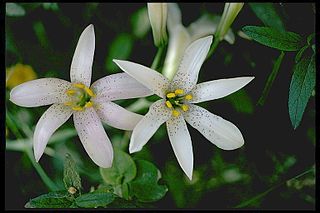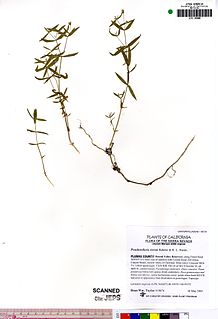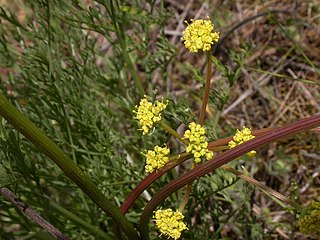
Limnanthes alba is a species of flowering plant in the meadowfoam family known by the common name white meadowfoam. It is native to California and Oregon, where it grows in wet grassy habitat, such as vernal pools and moist spots in woodlands. It generally grows in poorly drained soils. It is an annual herb producing an erect or decumbent stem up to about 30 centimeters long. The leaves divided into several lobed or unlobed leaflets. The flower is cup-shaped with white petals 1 to 1.5 centimeters long.

Limnanthes vinculans, the Sebastopol meadowfoam, is an endangered species of meadowfoam found only in the Laguna de Santa Rosa in Sonoma County, California, United States and an area slightly to the south in the Americano Creek and Washoe Creek watersheds. The name vinculans derives from the Latin root vinculum, meaning "a bond, a cord." The specific epithet vinculans means linking or bonding, in reference to the sharing of some characters of L. vinculans with L. douglasii (R.Br) and L. bakeri.

Acanthomintha ilicifolia, known by the common name San Diego thornmint, is a rare species of flowering plant in the mint family. It is native to Baja California and San Diego County, California, where it is a resident of the chaparral and coastal sage scrub plant communities and vernal pools.

Arctostaphylos pajaroensis is a species of manzanita known by the common name Pajaro manzanita. It is endemic to California, where it is known mainly from Monterey County.

Arctostaphylos stanfordiana, with the common name Stanford's manzanita, is a species of manzanita that is endemic to northern California. It is known from the outer North Coast Ranges north of the San Francisco Bay Area.
Arnica spathulata is a rare North American species of flowering plant in the family Asteraceae, known by the common name Klamath arnica. It is native to the Klamath Mountains of northwestern California and southwestern Oregon. It grows in woodland habitat, almost exclusively on serpentine soils.
Astragalus miguelensis is a rare species of milkvetch known by the common name San Miguel milkvetch. It is endemic to five of the eight Channel Islands of California.
Atriplex depressa is a species of saltbush known by the common names brittlescale and depressed orache. It is sometimes treated as a variety of Atriplex parishii.
Blennosperma bakeri is a rare species of flowering plant in the daisy family known by the common names Baker's stickyseed and Sonoma sunshine.

Clarkia imbricata is a rare species of flowering plant in the evening primrose family known by the common name Vine Hill clarkia. It is endemic to Sonoma County, California, where it is known from only one remaining natural occurrence near Vine Hill. A second natural population located on private land was extirpated when the owners plowed up the soil crust. The California Native Plant Society has established a third population from cuttings and is tending it in a reserve. This is a federally listed endangered species.

Limnanthes floccosa, or woolly meadowfoam, is a species of meadowfoam found in Northern California and Southern Oregon, in the United States. Most of the subspecies have highly restricted distributions and are listed as critical or endangered.
Horkelia wilderae is a rare species of flowering plant in the rose family known by the common name Barton Flats horkelia. It is endemic to San Bernardino County, California, where it is known from only about ten occurrences in the vicinity of Barton Flats. It grows in the montane chaparral and woodlands habitat where chaparral meets pine forest, and it is threatened by logging.

Lilium rubescens is an uncommon species of lily known by the common names redwood lily and chaparral lily. It is native to northwestern California and southwestern Oregon, where it is known from the Coast Ranges from Lane County to Santa Cruz Counties.
Limnanthes montana is a species of meadowfoam known by the common name mountain meadowfoam. It is endemic to the Sierra Nevada foothills of California, where it grows in wet, grassy habitat such as marshy spring meadows.
Limnanthes striata was formerly a species of meadowfoam known by the common name foothill meadowfoam. It has recently been subsumed into the species Limnanthes douglasii in both the Jepson Manual and the Flora of North America. This plant is endemic to California, where it is known from the Sierra Nevada foothills and the southern Klamath Mountains. It grows in wet, grassy habitat, carpeting the edges of vernal pools and ephemeral creeks.

Pseudostellaria sierrae is a species of flowering plant in the family Caryophyllaceae known by the common name Sierra starwort.
Streptanthus batrachopus is a rare species of flowering plant in the mustard family known by the common name Mt. Tamalpais jewelflower. It is endemic to Marin County, California, where it is known only from Mt. Tamalpais and surrounding terrain. There are fewer than ten known occurrences.

Thelypodium stenopetalum is a rare species of flowering plant in the mustard family known by the common names slenderpetal thelypody, slender-petaled thelypodium and slender-petaled mustard. It is endemic to the San Bernardino Mountains of southern California, where it is known from only three or four extant occurrences in moist mountain meadows near Big Bear Lake. Its remaining habitat is considered seriously threatened and the plant is a federally listed endangered species in the United States.

Arctostaphylos gabilanensis is a rare species of manzanita known by the common name Gabilan manzanita.

Lomatium cookii is a rare species of flowering plant in the carrot family known by the common names Cook's lomatium and agate desertparsley. It is endemic to Oregon in the United States, where it grows in only two valleys. It is a federally listed endangered species.













